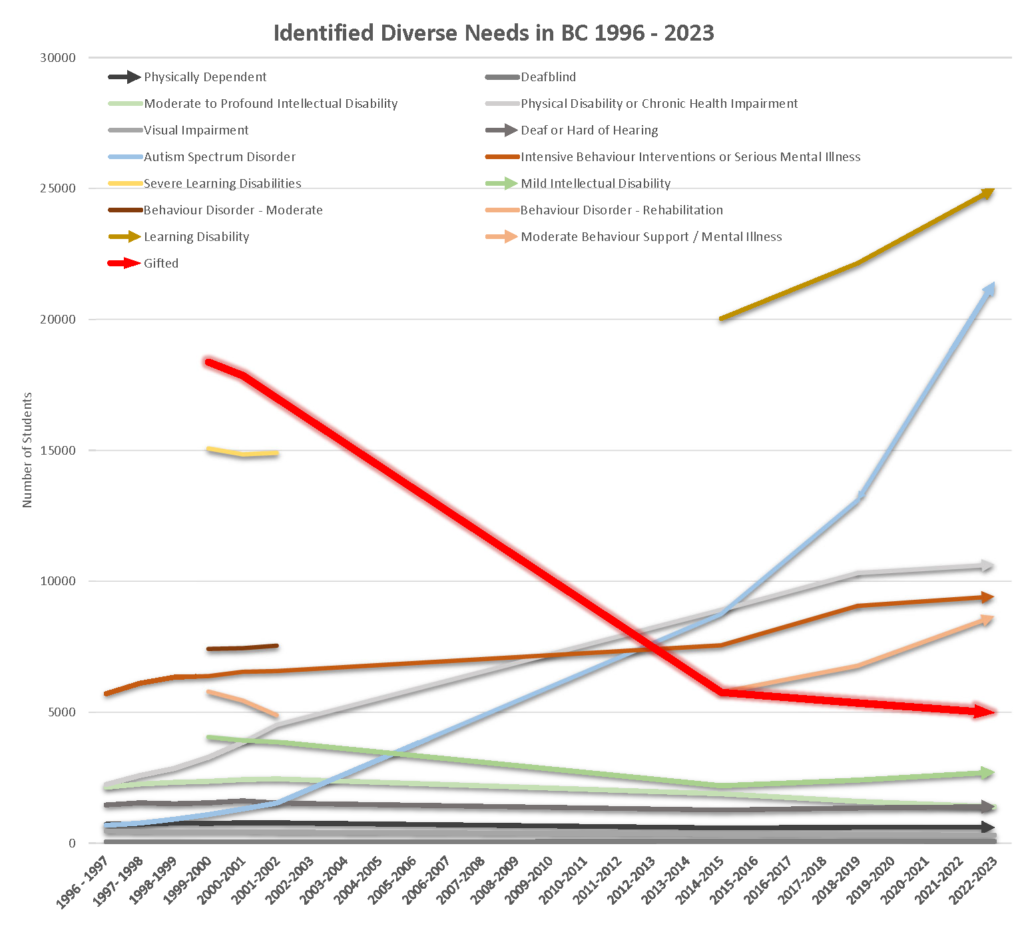Written by Maureen McDermid
For over two decades, the Ministry of Education and Child Care (MoEC) has collected the numbers of diverse or unique learners (i.e., ‘special needs’) reported by public schools and independent schools, including those identified with giftedness. For those educators and parents supporting students with unique developmental/learning needs, this data provides a picture of:
- The classifications/labels used to group these students and the changes in categories over time.
- The numbers of special education students reported in each category over the period between 1996 and 2023.
- A picture of the categories that the government has collected data on and whether numbers reported have declined, increased or remained stable over this period.
From the perspective of the Gifted Children’s Association of BC (GCABC), the information about the Gifted category is of primary interest. However, reported numbers in other ‘special needs’ categories also raise questions about what is being identified and reported, and why the numbers of students identified in these categories have fluctuated over time. Given that the overall student population in BC has continued to grow, it would be expected that the numbers of children identified as ‘Gifted’ would have increased or remained relatively proportionate to the population.
So, what does the data collection reveal about identification and reporting of Gifted learners?
It is important to begin with a history of this data collection. In the first year of collection and reporting, 1996-1997, giftedness was not listed as a category of unique learning needs or differences. The nine listed categories of data collected fell under the general umbrella of ‘Disabilities’. These included physical, mental, and intellectual disabilities, e.g. visual impairment, Deaf or hard of hearing, Moderate to profound intellectual disability, and the diagnostic category of Autism Spectrum Disorder.
In 1999-2000, four additional categories were added including, for the first time, Gifted. That year, school districts and independent schools across the province reported 18,372 Gifted students. Seven years later, in 2002-2003, the number of Gifted students reported dropped to 15,772 and by 2011-2012, the number had dropped to 6,753. The number of reported Gifted students continued to decline until in 2022-2023, the most recent year’s reporting, only 4,979 Gifted students were reported.
It is interesting that the first-year total school enrollment in BC was reported was 2021-2022. Student enrolment that year was 563,514 students and this has grown to 664,500 students reported in 2022-2023. In 2021-2022, 78,305 students with special needs were reported, an increase of 1,073 over the previous year. It is reasonable to assume that since 1999, the number of students in BC schools has increased each year and therefore the numbers of students in special education categories would likely have increased or remained stable. Reporting for some categories has fluctuated but stabilized over time. In contrast, numbers reported in some categories show an increase as the student population has grown. In one case only have the numbers reported declined each year: that is, Gifted!

For several decades, much of the literature on gifted education has put the number of Gifted learners in the school population as between 2 and 5% of the population, although recently, it has been suggested that a more accurate number would be 6%, National Association for Gifted Children (nagc.org). At 2%, the reported number of gifted students in BC schools for 2022-2023 would be 13,270; at 5%, this number would be 33,175. Currently the reported 4,979 gifted students are 0.74% of the reported enrolment in BC schools.
Where did BC’s gifted students go and why?
How is it possible that in BC, when it is generally accepted across education systems that the percentage of the population recognized as Gifted is between 2 and 5%, less that 1% of students are recognized as gifted? And how did a decline from the more than 2% of the population reported as gifted in 1999-2000 happen? There are some possible reasons related to management of the BC school system.
Funding support
In 2002, BC removed targeted funding for Gifted students although it was not clear why this was done. Prior to this time, Gifted students were reported and the Ministry provided a per pupil amount of money for support of the identified and reported student. It can be surmised that school districts and schools have placed less emphasis on identification and therefore support of Gifted students when the targeted funding was removed. The current process to obtain the small amount of funding for a reported Gifted designation comes within the base operational funding schools receive and is not targeted to be spent on identified students. There is little or no follow up or auditing to check if the funding is being spent in support of a reported learner. It is not clear why the targeted money was removed. Perhaps the Ministry of Education was acting on the faulty assumption that these are ‘Gifted students’, therefore, capable learners who do not need support, particularly academically. However, Gifted students have particular needs beyond academic support given their social and emotional differences related to asynchronous developmental and learning profiles.
Recognition of the learning attributes of the Gifted
Compared to the reported numbers in several of the other special needs categories, the generally accepted small percentage of Gifted learners in the general population may also contribute to lack of recognition. It is more difficult for them to find like-minded others who share learning traits such as:
- significantly less need for repetition of concepts and information, therefore being ready to move ahead in learning at a faster pace,
- asynchronous development when learning in specific curricular areas develops at different rates across several years,
- focussed and passionate interests in specific areas not necessarily shared with their chronological age group thus isolating them, and
- the scope of areas in which giftedness manifests itself: intellectual, academic, visual and performing arts, creativity, and leadership ability.
Since Gifted learners are relatively few in number compared to other learning differences, their unique developmental and learning needs are often overlooked. These attributes are not generally understood by educators and can be difficult to recognize in the classroom. Despite this small percentage, we hold that our education system is responsible for considering and supporting the unique needs of all learners. Expectations that this is a group of students that can take care of their own learning needs, as they have greater academic capacity than others, completely ignores the social-emotional needs of these students (i.e., their need for belonging) and/or their need to continue to progress in their learning at a rate appropriate to their capacity.
For instance, it is common and understandable for Gifted students to be frustrated with repetition and pace of learning. However, this frustration is often characterised and misattributed as behavioural. Unrecognized high ability or asynchronous development results in students sitting in classrooms with same-aged students who are presumed to be the appropriate peer group because of assumptions adults and educators make about human development. Their need to develop, and to be able to follow and be recognized for their interests and passions, is often not recognized and supported if it does not ‘fit’ with the teacher’s generalized curriculum planning. Additionally, schools tend to focus on intellectual and academic learning, often not recognizing the other areas where giftedness manifests itself, particularly leadership. This is important since the areas where they often need support, such as social and emotional aspects of learning, also often go unrecognized.
Teacher Education
The small percentage of students identified as Gifted is affected by the capacity of teachers to recognize their attributes and respond to them. Teacher Education Programs can do a much better job in supporting pre-service teachers to understand and respond appropriately to the unique developmental and learning needs of these students.
Teachers already in classrooms need support in order to identify and to provide support for the needs of Gifted learners. The current focus on inclusive classrooms is based on a belief that the needs of all learners can be adequately supported by a teacher and perhaps a classroom assistant; however, it is not clear that this plays out in practice. Ongoing professional development is key to this support.
While ongoing professional development is key to this support, a focus on professional development with respect to recognition and support for relatively small numbers of special needs learners in an inclusive environment is unlikely. The emphasis for professional development is more commonly focused on needs that are growing in number and intensity, therefore impacting the classroom more significantly. In the case of Gifted learners, there is a common belief that they should be academically capable and self-directed individuals, while the reality of diminishing resources that increase pressure on classroom teachers to meet wide ranging teaching and learning needs continues to go under-acknowledged.
In Summary
Alone among all the recognized special education categories in BC, why is Gifted the only category in which the numbers of identified learners have declined drastically? Are the numbers of students in this category too few and too scattered among the population to warrant a response? Does ‘inclusion’ mean that gathering these students in groups of like-minded (though not always same age) learners, a time honored and effective organizational strategy to meet their needs, is not permissible under this current philosophy? While it may be counterintuitive, the lack of attention and support for giftedness excludes and disables Gifted learners in practice. Developing anti-racist practices for the identification and support of racialized Gifted students is of utmost priority. Likewise, a high intellectual capacity requires appropriate instruction to not disable their learning continuity and development. In all cases, an appropriate classroom for Gifted students would provide access to other Gifted and like-minded students to support healthy relational development, as opposed to solely academic, achievement, and outcomes.
As with most children, and more than a few adults, when the learning or working situation is frustrating and does not fit the needs of the situation, the result is often behaviours that are inappropriate and disruptive. Are we possibly identifying Gifted learners as behavioral problems rather than understanding the need to adapt their learning environment? Does this result in including them in the growing reported numbers in the behavioural category? Is professional development for teachers and classroom aides regarding the recognition and response to these students’ exceptional and multi-exceptional learning needs not as important as that of other categories of ‘special education’?
The move across Canada to inclusive classrooms is based in a social justice view of education that all students should “feel that they belong and are accepted, safe, and valued in their school, so they can learn and succeed” (Nova Scotia’s Inclusive Education Plan, September 2020) While a worthy aspiration, the inclusion movement, while based in a recognition of marginalized groups of students and with a strong focus on disabilities, all very important issues for education and educators to recognize and address, has resulted in learning environments that have marginalized Gifted learners profoundly. Inclusion, as currently understood has not resulted in the equity it is meant to provide!
There are several ways that a system steeped in a policy of inclusion can respond if a more open version of inclusion is embraced. Inclusion for Gifted students in an appropriate curriculum level and learning community can be provided by student acceleration to work with concepts generally not taught in the curriculum at their chronological age, and the opportunity to learn with others performing at the same level of complexity. Given the small numbers, grouping Gifted learners together for instruction by qualified teachers so they can learn and progress to their capacity is another method of inclusion. To be included, these students, as all others, have the right to be taught by adults who recognize and can respond appropriately to their learning needs – this too is how we include! Given this data revealed across British Columbia’s school reporting of students with special needs, it is surely time that this information be investigated on the basis of equity, access and support for giftedness and multi-exceptionality just as equity and access is pursued in the other areas of ‘special needs’ recognized by the Ministry.
Appendix
Special Education Funding Designations – 2022-23
Students that are identified as having met the criteria for these designations are funded at the following levels for 2022-23:
- Level 1 $44,850
- Physically Dependent (A)
- Deafblind (B)
- Level 2 $21,280
- Moderate to Profound Intellectual Disability (C)
- Physical Disability or Chronic Health Impairment (D)
- Visual Impairment (E)
- Deaf or Hard of Hearing (F)
- Autism Spectrum Disorder (G)
- Level 3 $10,750
- Intensive Behaviour Interventions or Serious Mental Illness (H)
The following special education designations, if identified and reported to the Ministry received no ‘targeted funding’ but receive an additional allocation in the base allocation for the district or independent school that is expected to be used to support the identified learners:
The Basic Allocation provided for all students includes funds to support students with other special needs, including students with mild intellectual disabilities, learning disabilities, moderate behaviour support or mental illness, and students who are gifted. The Basic Allocation also includes funds to support boards of education in providing learning assistance, speech-language pathology services and physiotherapy services, hospital homebound services, and assessment services.
K-12 Funding – Special Needs – Province of British Columbia (gov.bc.ca)
Reported Special Education Data – Ministry of Education BC
| Identified Diverse Need | Provincial Numbers1996- 1997 | 1997-1998 | 1998-1999 |
| Physically Dependent | 720 | 733 | 760 |
| Deafblind | 51 | 52 | 58 |
| Moderate to Profound Intellectual Disability | 2131 | 2257 | 2322 |
| Physical Disability or Chronic Health Impairment | 2237 | 2587 | 2322 |
| Visual Impairment | 456 | 441 | 435 |
| Deaf or Hard of Hearing | 1460 | 1542 | 1508 |
| Autism Spectrum Disorder | 678 | 766 | 922 |
| Intensive Behaviour Interventions or Serious Mental Illness | 5704 | 6108 | 6339 |
| Identified Diverse Needs | Provincial Numbers1999-2000 | 2000-2001 | 2001-2002 |
| Physically Dependent | 757 | 777 | 773 |
| Deafblind | 38 | 42 | 46 |
| Moderate to Profound Intellectual Disability | 2359 | 2432 | 2455 |
| Physical Disability or Chronic Health Impairment | 3283 | 3853 | 4517 |
| Visual Impairment | 434 | 433 | 425 |
| Deaf or Hard of Hearing | 1544 | 1619 | 1530 |
| Autism Spectrum Disorder | 1090 | 1312 | 1523 |
| Intensive Behaviour Interventions or Serious Mental Illness | 6377 | 6540 | 6572 |
| Severe Learning Disabilities* | 15073 | 14846 | 14904 |
| Mild Intellectual Disability* | 4054 | 3929 | 3862 |
| Behaviour Disorder – Moderate* | 7418 | 7444 | 7542 |
| Behaviour Disorder – Rehabilitation* | 5790 | 5444 | 4887 |
| Gifted* | 18372 | 17858 | 16989 |
*Categories added in 1999-2000
| Identified Diverse Needs | Provincial Numbers2014-2015 | 2018-2019 | 2022-2023 |
| Physically Dependent | 584 | 606 | 605 |
| Deafblind | 79 | 74 | 71 |
| Moderate to Profound Intellectual Disability | 1887 | 1601 | 1389 |
| Physical Disability or Chronic Health Impairment | 8906 | 10315 | 10636 |
| Visual Impairment | 341 | 322 | 310 |
| Deaf or Hard of Hearing | 1265 | 1345 | 1398 |
| Autism Spectrum Disorder | 8746 | 13099 | 21438 |
| Intensive Behaviour Interventions or Serious Mental Illness | 7557 | 9061 | 9419 |
| Mild Intellectual Disability | 2195 | 2410 | 2708 |
| Gifted | 5757 | 5353 | 4979 |
| Learning Disability* | 20034 | 22148 | 24993 |
| Moderate Behaviour Support / Mental Illness* | 5767 | 6773 | 8669 |
*Categories added in 2014 – 2015



